Abstract
The biodegradation of crude oil is a consequence of the presence of a specific enzymatic system in the microorganisms selected: the alkane hydroxylase (AlkH). The enzymatic biodegradation has been described since 1994, when the enzyme was first isolated from P. putida (formerly P. oleovorans), but the kinetics of microbial degradation has been weakly considered. We studied and described in this work the kinetics of Arab Light biodegradation, a light crude oil used for gasoline production (46.4% C7–C12 n-alkanes), using two oleophilic strains (Bacillus licheniformis and Pseudomonas putida). Alkanes were extracted from aqueous solutions in the bioreactors by dichloromethane, with a high ratio aqueous:organic volumes (1:0.2 mL) for the amplification of the GC n-alkane signals, and GC spectra were monitored in time over 40 days. Petroleum emulsions were visualized using optical microscopy as a result of biosurfactant segregation, which is necessary for the enzymatic biodegradation of oil by microorganisms. Kinetic analysis in biodegradation of Arab Light (total petroleum hydrocarbons, TPH) exhibits first-order kinetics with 0.098 d−1 and 0.082 d−1 as kinetic coefficients for 8.6 g/L initial crude oil concentration (30 °C), which results in degradation rates of 843 mg/Ld and 705 mg/Ld in B. licheniformis and P. putida, respectively. These results can be applied for oil spill bioremediation, using these microorganisms with the objective of removing contamination by petroleum alkanes.
1. Introduction
Crude oil is a complex mixture of organic compounds, aliphatic and aromatic hydrocarbons, with the presence of high molecular weight asphaltenes (>C28) and condensed aromatics [1]. In light crude oils such as Arab Light, used for gasoline production, the presence of low molecular weight alkanes (C5–C16) is highly predominant, and the oil is clearly a mixture of aliphatic hydrocarbons, cycloalkanes, and benzene-derived compounds (toluene and xylene) [2]. In Arab Light, most of the components are n-alkanes and methyl-n-alkanes (C5–C9), n-pentane, n-hexane, n-heptane, n-octane, and n-nonane [2,3] are considered the predominant hydrocarbons in this light crude oil extracted in Saudi Arabia, especially in the Ghawar huge field.
The ability of bacteria to degrade crude oil is a consequence of the capability to produce the complex enzymatic system, which is characterized by an electron carrier-dependent monooxygenase system (alkane hydroxylases, AlkH) [2,4]. This monooxygenase system can be, for the degradation of C5-C10 alkanes, a rubredoxin-dependent enzyme or an alkane hydroxylase containing cytochrome P450 monooxygenases. The rubredoxin-dependent enzymes are located in the inner face of the cellular membrane, and the Cyt-P450 enzymes are soluble in the cytoplasm. The first AlkH was isolated from P. putida (formerly P. oleovorans) and was a rubredoxin-dependent alkane hydroxylase [5].
The rubredoxin-dependent enzyme system is a diiron monooxygenase complex formed by an electron transfer system considered to be divided into three components (Figure 1). The first component is an NADH/ rubredoxin reductase (AlkT) followed by a [2Fe-2S] soluble rubredoxin (AlkG) and a diiron monooxygenase integrated into the cell membrane (AlkB). This type of multicomponent enzyme system has been described widely in bacteria [4,6,7,8,9]. Alkane monooxygenase (AlkB) adopts the oxygen rebound mechanism to hydroxylate alkanes C5–C16 preferably, as in other enzymatic systems, for example, soluble methane monooxygenase (sMMO) for the degradation of methane by methanotrophs.
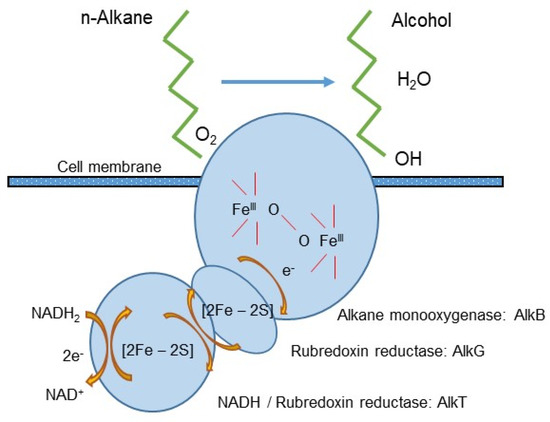
Figure 1.
Rubredoxin-dependent enzyme system, an electron transfer system of alkane monooxygenase (AlkB-type). Based on [2,4].
Metabolism of hydrocarbons by microorganisms is considered a complex process in which hydrocarbons, metabolically inactive molecules, are converted to more active compounds for further catalysis [10]. In the first step, most commonly, n-alkanes are oxidized by monooxygenases incorporating an oxygen atom from O2 into the hydrocarbon to form the corresponding alkan-1-ol (Figure 1) [2,4]. Although the enzymatic cascade can be different depending on the microorganism and substrate, the final product from hydrocarbon degradation is frequently similar, and the same enzymatic system can degrade different hydrocarbons because most of the alkane-degrading enzymes have a wide substrate range [2]. The main reason for the difficulty in hydrocarbon degradation by bacteria in aquatic systems is their low water solubility, resulting in slower metabolism of high molecular weight hydrocarbons than low molecular weight hydrocarbons, which are more soluble in water [2].
Although treatment of contamination by petroleum hydrocarbons is difficult and laborious work [11,12], recently, an important number of bacteria genera isolated from contaminated sites has been described for crude oil hydrocarbons degradation [9,13,14], especially for C5-C10 n-alkanes, which seem to be more suitable for biodegradation [2,3,13].
Kinetic studies of crude oil degradation and hydrocarbons are scarce in the literature [15,16,17] and would help to a high extent to restore contaminated sites by hydrocarbons and oil spills. Specific degradation rates and kinetic coefficients of bacteria quantify degradation capacity and are the reference for choosing the adequate strain for the specific substrates and environmental conditions. We will perform in this article a detailed study of the kinetics of Arab Light oil degradation by two bacteria strains, which belong to the Pseudomonas and Bacillus genera. The objective of this work is to obtain the values of the degradation rates and kinetic coefficients for the ex situ biodegradation of the oil in stirring and temperature-controlled bioreactors. The composition of petroleum will be studied in depth, related to the biodegradation of the different fractions of n-alkanes, with the objective of restoring sites contaminated by crude oil spills.
2. Materials and Methods
2.1. Microorganisms and Enrichments
Two microorganisms, isolated in the laboratory and deposited in the Spanish Type Culture Collection, with proven activity in crude oil degradation in previous experiments, were used with Arab Light as substrate: Bacillus licheniformis (CECT 20) and Pseudomonas putida (CECT 4614) [17,18,19,20]. Enrichments of these strains were cultured twice in agar plates with crude oil (Arab Light, 1% v/v) as the only carbon source, Basal Minimum Medium (BMM: 70 mg/L NaCl, 40 mg/L CaCl. H2O, and 40 mg/L MgSO4. 7H2O), and pure agar (12 g/L).
2.2. Analytical Methods
2.2.1. Crude Oil Characterization
Crude oil was characterized by GC-MS (Agilent 7890A coupled to Agilent MS220, Santa Clara, CA, USA) in a VF5MS column (30 m × 0.25 mm × 0.25 m). Helium was the carrier gas at 1 mL/min with a 20:1 split ratio, and the oven program started at 50 °C for 5 min, increased to 270 °C at 10 °C/min, and this temperature was finally held for 5 min (total analysis time 32 min). The sample volume was 1 L.
2.2.2. Crude Oil Measurements
Arab Light concentration was measured using a GC-FID (Agilent 6890 N, Santa Clara, CA, USA) with a capillary Wax column (BP20-SGE Analytical Science, 30 m × 0.25 mm × 0.25 m). Nitrogen was the carrier gas (flow rate 1.40 mL/min), and the FID detector was set at 260 °C with 40 mL/min H2 flow and 450 mL/min airflow. The GC oven temperature program was fixed in accordance with the literature for crude oil analysis [16,17]. After several attempts, the GC oven temperature program was adjusted for the best C7–C30 chromatogram results. The temperature program started at 50 °C for 2 min, increased to 260 °C at 7 °C/min, and this temperature was subsequently maintained for 2 min (total analysis time 34 min). The sample volume used was 1 L, and the syringe was washed 10 times with the analyte before analysis. In between different samples, the syringe was washed 5 times with dichloromethane (DCM).
2.3. Experimental Degradation Assays
Kinetics of oil degradation were performed with 1% v/v crude oil in Mineral Salt Medium (MSM: 2.2 g/L NaHPO4, 1.4 g/L KH2PO4, 3 g/L (NH4)2SO4, 0.6 g/L MgSO4.7H2O, 10 g/L NaCl, 0.01 g/L FeSO4.7H20, 0.02 g/L CaCl2, pH = 7.9). This liquid medium was selected instead of BMM because of the presence of nutrients (PO43−, NH4+, K+) and Fe2+, which have been described to be necessary for the bacterial metabolism of hydrocarbons [1,16,21,22,23].
Experimental degradation was developed in 500 mL thermostatically controlled reactors at 30 ºC with magnetic stirring at 900 rpm (Figure 2). This temperature was selected in the mesophilic range according to optimal growth temperatures for Pseudomonas and Bacillus (especially P. putida). A total of 250 mL of MSM were introduced in each reactor, inoculated with bacteria grown in crude oil agar plates. Initial crude oil concentration was 1% v/v (8.6 g/L, density 0.86 g/mL), and oil concentration was measured two times a week by GC-FID, two replicates to assure reproducibility. A control experiment (without bacteria inoculum) was also performed.
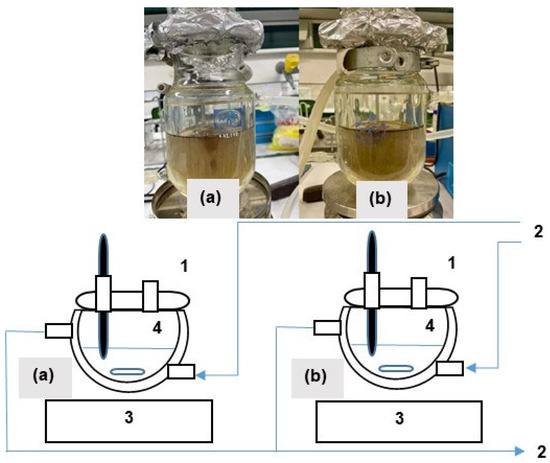
Figure 2.
Experimental setup for crude oil degradation in liquid media. Reactor (1) temperature is controlled by a thermostat (2) and magnetically stirred (3). Liquid level in the reactor is half the value (4) of the total volume: 500 mL, and crude oil concentration is fixed in 1% v/v. (a) Bacillus licheniformis (CECT 20); (b) Pseudomonas putida (CECT 4614).
To evaluate oleophilic bacterial growth, optical density (OD) was measured in triplicate. Aqueous samples (1 mL) were taken directly from the bioreactor and mixed with the extractor (dichloromethane, DCM) in the appropriate ratio (0.2–0.5 mL) for correct amplification and detection of the signal by GC-FID.
2.4. Optical Microscopy Photographs
Optical microscopy (Leica DM 1000, 10X, and 100X) was used to visualize the formation of oil emulsions in water due to the presence of Bacillus licheniformis and Pseudomonas putida after transferring 10 μL of sample to a slide directly from the bioreactors.
2.5. Crude Oil Biodegradation Kinetics
Crude oil biodegradation kinetics was assayed by first-order kinetics related to substrate concentration:
where r is the reaction rate, S substrate concentration and k the kinetic coefficient. Equation (1) can be written in the differential form:
Being t the time and integrating by separated variables, where So is the initial substrate concentration:
Equation (5) (logarithmic form) can be written in exponential form in Equation (6):
This is the expression for substrate (petroleum) concentration decay according to first-order kinetics, in which the substrate (S) has been removed exponentially from the initial concentration So. Kinetic coefficient k is related directly to the amount of substrate removed in time; it makes the degradation rate r increase (Equation (1)). Degradation rate r is dependent on substrate concentration in Equation (1) and on the activity of the microorganisms, especially temperature.
3. Results and Discussion
3.1. Crude Oil Characterization
Arab Light characterization by GC-MS (Figure 3) shows a high presence of aliphatic hydrocarbons and isomers with a predominance of low molecular weight n-alkanes (C7–C12), although the distribution of organic compounds ranges widely from C7 to C29. The abundance of ramified isomers and some aromatics can be observed, especially below C15. Over C22, the abundance of n-alkanes is reduced in this light oil (<0.25%). In view of these results about the composition of Arab Light, the kinetics of crude oil degradation was focused on n-alkanes below C23, which represent 91.1% of the total content of C7–C29 alkanes in this crude oil.
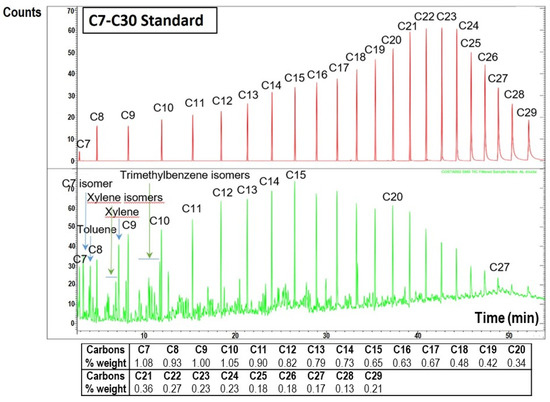
Figure 3.
Arab Light characterization by GC–MS. The upper graph (red color spectrum) is the standard for C7–C30 aliphatic hydrocarbons and the lower graph is the result of Arab Light characterization (green color spectrum). C30 n-alkane is not shown in the standard (not detected in Arab Light oil). The table below shows the composition in% weight of aliphatic hydrocarbons in this light crude oil, with a majority of C7–C12 compounds (individual abundance > 0.80%). The percentage of C7–C12 n-alkanes over the global percentage of C7–C29 aliphatic alkanes distribution is 46.4%.
3.2. Sample Analysis: Extraction and Amplification
Calibration for crude oil analysis by GC-FID is shown in Figure 4a, in which a standard solution of C7–C30 alkanes was injected for alkanes identification, and signals of C7–C10 have been enlarged for better visualization. Two solvents were present in the chromatograms of crude oil characterization, hexane (solvent of n-alkanes standard solution) and DCM (extraction solvent of crude oil samples in water).
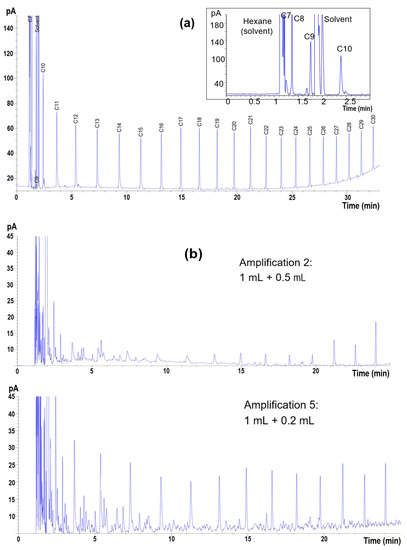
Figure 4.
Calibration of C7–C30 alkanes by GC-FID using Sigma-Aldrich standard (2000 g/mL, 2 g/L diluted 1:10 in DCM) in the upper chromatogram (a), with retention times of C7–C10 in detail. Chromatograms showing amplification of the signal of the samples of crude oil (1% v/v, 8.6 g/L) in the lower spectra (b): (aqueous sample volume) + (DCM organic extractor volume).
Due to the low solubility of oil in water, when crude oil biodegradation is monitored in aqueous solutions, an extraction and detection method for alkanes by GC has to be designed. Selection of the extraction solvent is very important [24], and it has to be not highly volatile in order to be stable during the extraction procedure. In addition, to extract analytes to a high extent and GC solvent signal has to not interfere with alkane peaks. Several extracting solvents were investigated: methanol, isopropanol, pentane, hexane, and dichloromethane (DCM), concluding DCM to be the appropriate solvent for crude oil extraction and GC analysis of alkane samples [16,17].
Due to the low concentration of oil in aqueous solution, an amplification of the signals was designed for detection by GC. The amplification was based on the ratio of aqueous:organic phases because increasing the ratio (reducing organic phase volume) results in concentration of oil in the organic (extractor) phase. When the ratio was 5:1, 1 mL aqueous sample was collected from bioreactors in a 5 mL glass bottle, and 0.2 mL DCM was added to the sample and agitated several times for crude oil extraction (amplification 5). Before injection in the GC of the organic phase placed in the bottom of the glass bottle, the sample was decanted for 15 min. Results are summarized in Figure 4b, in which amplification 5 for crude oil concentration 8.6 g/L (1% v/v) appears to be adequate for the detection of alkanes in water solutions for the concentration range used in this work.
3.3. Crude Oil Degradation
Crude oil degradation by the two strains (B. licheniformis and P. putida) was monitored by GC measurements in the bioreactors. B. licheniformis showed much better degradation for C7–C12 alkanes (Figure 5), a situation observed by other authors [15,25], while P. putida seems to exhibit a broader range of alkanes degraded, maintaining a more regular profile of n-alkanes removed in the GC spectra (Figure 6). In both cases, most alkanes disappear after 30 days.
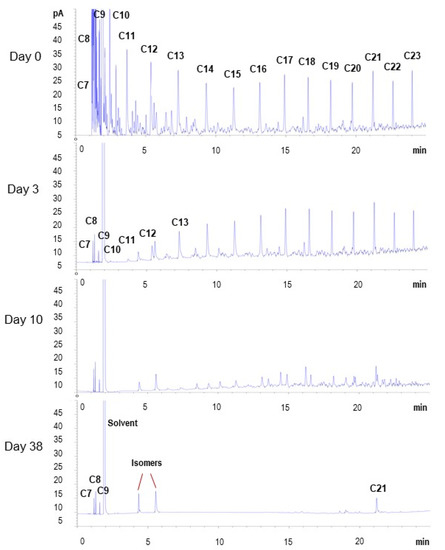
Figure 5.
GC-FID chromatograms of Arab Light degradation by Bacillus licheniformis. C7–C12 aliphatic alkanes are quickly degraded. Residual signals in the last chromatogram (day 38) are not significant in area value (<10 pA*s).
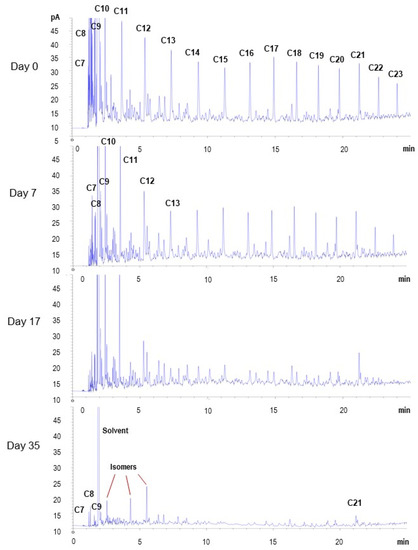
Figure 6.
GC-FID chromatograms of Arab Light degradation by Pseudomonas putida. Degradation of C7–C12 aliphatic alkanes is lower during the first days of incubation compared to B. licheniformis. Residual peaks in the last chromatogram (day 35) are not significant in area value (<10 pA*s).
It is remarkable, and visualized in Figure 5 and Figure 6, at the end of the biodegradation experiments (days 38 and 35 in Figure 5 and Figure 6, respectively), that low molecular weight (MW) n-alkanes (<C9) are still present in trace concentrations (<5 pA*s), while medium MW n-alkanes (C10–C24), less volatile, disappeared for been degraded. This can be explained because short-chain n-alkanes are cited to be toxic to many microorganisms [26], including heptane, octane, and nonane, which is an important factor to be considered in crude oil bioremediation by oleophilic microbes. C10–C18 n-alkanes seem to be the most biodegradable hydrocarbons, not only in this work, because other authors consider C18–C23 hydrocarbons difficult to be attacked by microorganisms [27,28]. In Figure 5 and Figure 6, C21 n-alkane also appears as a recalcitrant hydrocarbon, difficult to be degraded.
Although, as mentioned previously, the low solubility of oil in water is the main difficulty for bacterial bioremediation of crude oil spills, some authors cited the ability to produce biosurfactants by oil-degrading bacteria [18,22,24,29]. The formation of emulsions in water is needed as a previous step for oil degradation [3,19,26,30,31,32], and biosurfactants play an important role in favoring interaction between microorganisms and insoluble substrate because diffusion limitation during substrate transport to the cell is overcome [33,34,35]. The formation of this emulsion can be visualized in Figure 7, in which microphotographs of bacterial cultures from the bioreactors show oil emulsions in water as small spherical yellowish drops in 100x captures. With this distribution of the oil spread in water, the enzymatic system of oil degraders can act over alkanes and produce biodegradation.
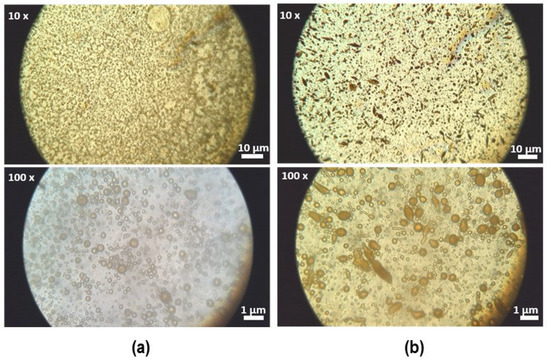
Figure 7.
Microphotographs of Bacillus licheniformis (a) and Pseudomonas putida (b) from the bioreactors at 10X and 100X. Crude oil dispersions promoted by extracellular biosurfactants can be observed in 100X microphotographs.
3.4. Degradation Kinetics
Crude oil degradation kinetic data are very scarce in the literature, and normally it has been expressed as a percentage of the oil biodegraded [15,17] or individual alkanes [11]. Some authors cited Monod kinetics and calculated kinetic parameters in crude oil biodegradation [16]. A method to study crude oil biodegradation, due to the complex mixture of hydrocarbons, is to monitor TPH (total petroleum hydrocarbons) as the sum of alkanes measured [17,27,36].
Degradation kinetics of B. licheniformis and P. putida have been studied as TPH reduction over time in the bioreactors for 40 days. TPH was calculated as the sum of all peak areas for the GC spectra C7–C23 during bacterial degradation and expressed in the concentration of oil present in aqueous cultures (transferring initial TPH to initial concentration). In Figure 8, a kinetic study of degradation curves has been performed, considering the original decay of TPH concentration versus time to obtain TPH degradation rates for both microorganisms. At the same time of oil degradation, optical density highly increases to stabilization after day 20, when crude oil concentration decreases below 2 g/L.
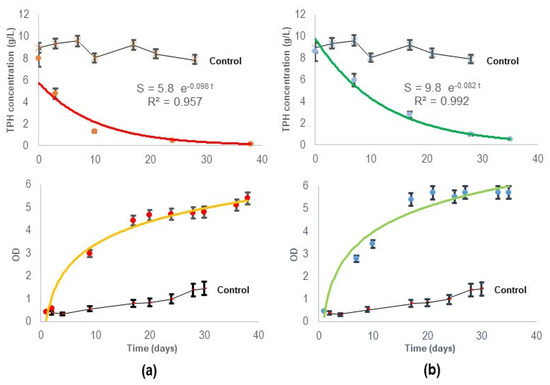
Figure 8.
Kinetic curves of Arab Light degradation (measured as TPH) and optical density by Bacillus licheniformis (a) and Pseudomonas putida (b). Error bars represent standard deviation (triplicates). Control shows a weak growth of no oleophilic microorganisms (no TPH decay).
In accordance with Figure 8, both microorganisms exhibit an exponential relationship between substrate and time (first-order kinetics, Equation (6)):
Recently, in several articles about ex situ individual hydrocarbons biodegradation [37,38] and heavy crude oil [39] in soil and aqueous solution experiments by Pseudomonas and Bacillus sp., a first-order kinetics has been observed, and for in situ biodegradation of oil in soil and beaches, a first-order kinetics is actually accepted [40,41].
Degradation rates for both microorganisms can be written as follows, in accordance with Equation (1) and for the corresponding kinetic coefficients obtained in Figure 8:
rB.licheniformis = −0.098 S ….. (mg/Ld)
rP.putida = −0.082 S ….. (mg/Ld)
Although kinetic coefficients in both microorganisms are proximate, B. licheniformis exhibits a higher potential for crude oil degradation (higher value of kinetic coefficient) and could be more appropriate for bioremediation of petroleum spills in aqueous solutions because a higher value of the kinetic coefficient k results in a higher degradation rate r.
In this work, the use of oleophilic microbes for biodegradation of Arab Light crude oil reaches degradation rates of 843 mg/Ld and 705 mg/Ld in Bacillus licheniformis and Pseudomonas putida, respectively. These values are obtained for the initial concentration of crude oil, So = 8.6 g/L (1% v/v, density of Arab Light 0.86 g/mL) expressed in mg/L in Equations (9) and (10) and for the conditions of the experiments in the bioreactors at 30 °C (negative values, degradation rates for crude oil removal).
These microorganisms can be used effectively in ex situ bioremediation of crude oil spills, and kinetic parameters are essential to project bioreactor size and the time range in biodegradation assays. With Equations (9) or (10), depending on the microorganism selected, and for the crude oil concentration S, degradation rates are obtained. Degradation rate means the decrease in oil concentration per unit of time; in Equations (9) and (10) mg/Ld, depending on the amount of oil to be treated, reactor size can be projected in accordance with the desired oil concentration in aqueous solution (e.g., 1% v/v). Time for ex situ bioremediation is directly the initial concentration of petroleum divided by the degradation rate.
4. Conclusions
B. licheniformis (CECT 20) and P. putida (CECT 4614) are two strains with the ability to degrade Arab Light crude oil, which is used for the production of gasoline. These microorganisms produce biosurfactants that can overcome the diffusion limitation of insoluble oil during transport to the cell. Crude oil emulsions, as proof of biosurfactants segregation, have been visualized in this article by optical microscopy at 100 X.
To follow TPH concentration by GC-FID during the biodegradation of oil in aqueous solutions, an extracting and signal-amplifying method has been designed in this work. The extracting solvent selected was dichloromethane, and the amplifying method designed was the ratio aqueous:organic solutions, resulting in a ratio of 5 as the most adequate for the oil concentrations analyzed.
The kinetics of Arab Light degradation by these two strains is described by a first-order equation. Although both microorganisms have high degradation rates, B. licheniformis exhibits better properties (higher value of kinetic coefficient) related to the bioremediation of crude oil in aqueous solutions.
Author Contributions
C.C. designed the research and project outline, and drafted, wrote, and reviewed the manuscript. M.A.V. prepared and fitted calibration and GC samples. A.S. performed experimental research in bioreactors. All authors have read and agreed to the published version of the manuscript.
Funding
This study was financed by the University of Salamanca, C1 Financial Program 2021. Project 18.KA.5N.
Institutional Review Board Statement
Not applicable.
Informed Consent Statement
Not applicable.
Data Availability Statement
All data used are in the manuscript.
Acknowledgments
César Raposo, from the GC-MS Analysis Service of the University of Salamanca, is gratefully acknowledged for the characterization of Arab Light crude oil and interpretation of the GC-MS spectra. Alejandro Llanos from REPSOL S.A. kindly provided samples of Arab Light and the physical properties of this crude oil.
Conflicts of Interest
The authors declare no conflict of interest. The funders did not participate in any part of the research or elaboration of the manuscript.
Abbreviations
| AlkH | alkane hydroxylase |
| BMM | basal minimum medium |
| DCM | dichloromethane |
| MSM | mineral salt medium |
| MW | molecular weight |
| sMMO | soluble monooxygenase |
| TPH | total petroleum hydrocarbons |
| S | substrate concentration (mg/L) |
| So | initial substrate concentration (mg/L) |
| r | degradation rate (mg/Ld) |
| k | kinetic coefficient (d−1) |
| t | time (d) |
References
- Atlas, R.M.; Hazen, T.C. Oil biodegradation and bioremediation: A tale of the two worst spills in U.S. history. Environ. Sci. Technol. 2011, 45, 6709–6715. [Google Scholar] [CrossRef] [PubMed]
- Abbasian, F.; Lockington, R.; Mallavarapu, M.; Naidu, R. A comprehensive review of aliphatic hydrocarbon biodegradation by bacteria. Appl. Biochem. Biotechnol. 2015, 176, 670–699. [Google Scholar] [CrossRef] [PubMed]
- Varjani, S.J. Microbial degradation of petroleum hydrocarbons. Bioresour. Technol. 2017, 223, 277–286. [Google Scholar] [CrossRef]
- Morikawa, M. Dioxygen activation responsible for oxidation of aliphatic and aromatic hydrocarbon compounds: Current state and variants. Appl. Microbiol. Biotechnol. 2010, 87, 1595–1603. [Google Scholar] [CrossRef] [PubMed]
- Van Beilen, J.B.; Wubbolts, M.G.; Witholt, B. Genetics of alkane oxidation by Pseudomonas oleovorans. Biodegradation 1994, 5, 161–174. [Google Scholar] [CrossRef]
- Van Beilen, J.B.; Funhoff, E.G. Alkane hydroxylases involved in microbial alkane degradation. Appl. Microbiol. Biotechnol. 2007, 74, 13–21. [Google Scholar] [CrossRef]
- Paisse, S.; Duran, R.; Coulon, F.; Goñi-Urriza, M. Are alkane hydroxylase genes (alkB) relevant to assess petroleum bioremediation processes in chronically polluted coastal sediments? Appl. Microbiol. Biotechnol. 2011, 92, 835–844. [Google Scholar] [CrossRef]
- Viggor, S.; Jöesaar, M.; Vedler, E.; Kiiker, R.; Pärnpuu, L.; Heinaru, A. Occurrence of diverse alkane hydroxylase alkB genes in indigenous oil-degrading bacteria of Baltic Sea surface water. Mar. Pollut. Bull. 2015, 101, 507–516. [Google Scholar] [CrossRef]
- Rehman, K.; Arslan, M.; Müller, J.A.; Saeed, M.; Imran, A.; Amin, I.; Mustafa, T.; Iqbal, S.; Afzal, M. Bioaugmentation-Enhanced Remediation of Crude Oil Polluted Water in Pilot-Scale Floating Treatment Wetlands. Water 2021, 13, 2882–2896. [Google Scholar] [CrossRef]
- Ladygina, N.; Dedyukhina, E.; Vainshtein, M. A review on microbial synthesis of hydrocarbons. Proc. Biochem. 2006, 41, 1001–1014. [Google Scholar] [CrossRef]
- Barathi, S.; Vasudevan, N. Utilization of petroleum hydrocarbons by Pseudomonas fluorescens isolated from a petroleum-contaminated soil. Environ. Int. 2001, 26, 413–416. [Google Scholar] [CrossRef] [PubMed]
- Ossai, I.C.; Ahmed, A.; Hassan, A.; Hamid, F.S. Remediation of soil and water contaminated with petroleum hydrocarbon: A review. Environ. Technol. Innov. 2020, 17, 100526. [Google Scholar] [CrossRef]
- Yang, R.; Liu, G.; Chen, T.; Zhang, W.; Zhang, G.; Chang, S. The complete genomic sequence of a novel cold-adapted bacterium, Planococcus maritimus Y42, isolated from crude oil-contaminated soil. Stand. Genom. Sci. 2018, 13, 23–31. [Google Scholar] [CrossRef] [PubMed]
- Wu, B.; Deng, J.; Niu, H.; Liang, J.; Arslan, M.; El-Din, M.G.; Wang, Q.; Guo, S.; Chen, C. Establishing and Optimizing a Bacterial Consortia for Effective Biodegradation of Petroleum Contaminants: Advancing Classical Microbiology via Experimental and Mathematical Approach. Water 2021, 13, 3311–3323. [Google Scholar] [CrossRef]
- Obayori, O.S.; Adebusoye, S.A.; Adewale, A.O.; Oyetibo, G.O.; Oluyemi, O.O.; Amokun, R.A.; Ilori, M.O. Differential degradation of crude oil (Bonny Light) by four Pseudomonas strains. J. Environ. Sci. 2009, 21, 243–248. [Google Scholar] [CrossRef]
- Chettri, B.; Mukherjee, A.; Langpoklakpam, J.S.; Chattopadhyay, D.; Singh, A.K. Kinetics of nutrient enhanced crude oil degradation by Pseudomonas aeruginosa AKS1 and Bacillus sp. AKS2 isolated from Guwahati refinery, India. Environ. Pollut. 2016, 216, 548–558. [Google Scholar] [CrossRef]
- Zheng, M.; Wang, W.; Hayes, M.; Nydell, A.; Tarr, M.A.; Van Bael, S.A.; Papadopoulos, K. Degradation of Macondo 252 oil by endophytic Pseudomonas putida. J. Environ. Chem. Eng. 2018, 6, 643–648. [Google Scholar] [CrossRef]
- Kumari, B.; Singh, S.N.; Singh, D.P. Characterization of two biosurfactant producing strains in crude oil degradation. Proc. Biochem. 2012, 47, 2463–2471. [Google Scholar] [CrossRef]
- Sajna, K.V.; Sukumaran, R.K.; Gottumukkala, L.D.; Pandey, A. Crude oil biodegradation aided by biosurfactants from Pseudozyma sp. NII 08165 or its culture broth. Bioresour. Technol. 2015, 191, 133–139. [Google Scholar] [CrossRef]
- Silva, B.M.; Maranho, L.T. Petroleum-contaminated sites: Decision framework for selecting remediation technologies. J. Hazard. Mat. 2019, 378, 120722. [Google Scholar] [CrossRef]
- Varjani, S.J.; Upasani, V.N. A new look on factor affecting microbial degradation of petroleum hydrocarbon pollutants. Int. Biodeterior. Biodegrad. 2017, 120, 71–83. [Google Scholar] [CrossRef]
- Ron, E.Z.; Rosenberg, E. Enhanced bioremediation of oil spills in the sea. Curr. Opin. Biotechnol. 2014, 27, 191–194. [Google Scholar] [CrossRef] [PubMed]
- Atlas, R.M.; Bragg, J.R. Bioremediation of marine oil spills: When and when not—The Exxon Valdez experience. Microb. Biotechnol. 2009, 2, 213–221. [Google Scholar] [CrossRef] [PubMed]
- Zanjani, M.K.; Yamini, Y.; Shariati, S. Analysis of n-alkanes in water samples by means of headspace solvent microextraction and gas chromatography. J. Hazad. Mat. 2006, B136, 714–720. [Google Scholar] [CrossRef]
- Ozyurek, S.B.; Bilkay, I.S. Comparison of petroleum biodegradation efciencies of three diferent bacterial consortia determined in petroleum-contaminated waste mud pit. SN Appl. Sci. 2020, 2, 272–283. [Google Scholar] [CrossRef]
- Chandra, S.; Sharma, R.; Singh, K.; Sharma, A. Application of bioremediation technology in the environment contaminated with petroleum hydrocarbon. Ann. Microbiol. 2013, 63, 417–431. [Google Scholar] [CrossRef]
- Bajagain, R.; Park, Y.; Jeong, S.W. Feasibility of oxidation-biodegradation serial foam spraying for total petroleum hydrocarbon removal without soil disturbance. Sci. Total Environ. 2018, 626, 1236–1242. [Google Scholar] [CrossRef]
- Bajagain, R.; Gautam, P.; Jeong, S.W. Biodegradation and post-oxidation of fuel-weathered field soil. Sci. Total Environ. 2020, 734, 139452. [Google Scholar] [CrossRef]
- Xia, M.; Fu, D.; Chakraborty, R.; Singh, R.P.; Terry, N. Enhanced crude oil depletion by constructed bacterial consortium comprising bioemulsifier producer and petroleum hydrocarbon degraders. Bioresour. Technol. 2019, 282, 456–463. [Google Scholar] [CrossRef]
- Varjani, S.J.; Upasani, V.N. Carbon spectrum utilization by an indigenous strain of Pseudomonas aeruginosa NCIM 5514: Production, characterization and surface active properties of biosurfactant. Bioresour. Technol. 2016, 221, 510–516. [Google Scholar] [CrossRef]
- Zhao, F.; Zhou, J.-D.; Ma, F.; Shi, R.-J.; Han, S.-Q.; Zhang, J.; Zhang, Y. Simultaneous inhibition of sulfate-reducing bacteria, removal of H2S and production of rhamnolipid by recombinant Pseudomonas stutzeri Rhl: Applications for microbial enhanced oil recovery. Bioresour. Technol. 2016, 207, 24–30. [Google Scholar] [CrossRef] [PubMed]
- Abdullah, S.R.S.; Al-Baldawi, I.A.; Almansoory, A.F.; Purwanti, I.F.; Al-Sbani, N.H.; Sharuddin, S.S.N. Plant-assisted remediation of hydrocarbons in water and soil: Application, mechanisms, challenges and opportunities. Chemosphere 2020, 247, 125932. [Google Scholar] [CrossRef]
- Cerqueira, V.S.; Hollenbach, E.B.; Maboni, F.; Vainstein, M.; Camargo, F.; Do-Carmo, R.P.M.; Bento, F.M. Biodegradation potential of oily sludge by pure and mixed bacterial cultures. Bioresour. Technol. 2011, 102, 11003–11010. [Google Scholar] [CrossRef] [PubMed]
- Wang, X.B.; Chi, C.Q.; Nie, Y.; Tang, Y.Q.; Tan, Y.; Wu, G.; Wu, X.L. Degradation of petroleum hydrocarbons (C6–C40) and crude oil by a novel Dietzia strain. Bioresour. Technol. 2011, 102, 7755–7761. [Google Scholar] [CrossRef] [PubMed]
- Kavitha, V.; Mandal, A.B.; Gnanamani, A. Microbial biosurfactant mediated removal and/or solubilization of crude oil contamination from soil and aqueous phase: An approach with Bacillus licheniformis MTCC 5514. Int. Biodeterior. Biodegrad. 2014, 94, 24–30. [Google Scholar] [CrossRef]
- Beskoski, V.P.; Gojgic-Cvijovic, G.; Milic, J.; Ilic, M.; Miletic, S.; Solevic, T.; Vrvic, M.M. Ex situ bioremediation of a soil contaminated by mazut (heavy residual fuel oil)–a field experiment. Chemosphere 2011, 83, 34–40. [Google Scholar] [CrossRef]
- Hajieghrari, M.; Hejazi, P. Enhanced biodegradation of n-Hexadecane in solid-phase of soil by employing immobilized Pseudomonas Aeruginosa on size-optimized coconut fibers. J. Hazard. Mat. 2020, 389, 122134. [Google Scholar] [CrossRef]
- Sharma, S.; Pandey, L.M. Biodegradation kinetics of binary mixture of hexadecane and phenanthrene by the bacterial microconsortium. Bioresour. Technol. 2022, 358, 127408. [Google Scholar] [CrossRef]
- Liu, Y.; Wan, Y.Y.; Wang, C.; Ma, Z.; Liu, X.; Li, S. Biodegradation of n-alkanes in crude oil by three identified bacterial strains. Fuel 2020, 275, 117897. [Google Scholar] [CrossRef]
- Boufadel, M.C.; Geng, X.; Short, J. Bioremediation of the Exxon Valdez oil in Prince William Sound beaches. Mar. Poll. Bull. 2016, 113, 156–164. [Google Scholar] [CrossRef]
- Geng, X.; An, C.; Lee, K.; Boufadel, M.C. Modeling oil biodegradation and bioremediation within beaches. Curr. Op. Chem. Eng. 2022, 35, 100751. [Google Scholar] [CrossRef]
Publisher’s Note: MDPI stays neutral with regard to jurisdictional claims in published maps and institutional affiliations. |
© 2022 by the authors. Licensee MDPI, Basel, Switzerland. This article is an open access article distributed under the terms and conditions of the Creative Commons Attribution (CC BY) license (https://creativecommons.org/licenses/by/4.0/).